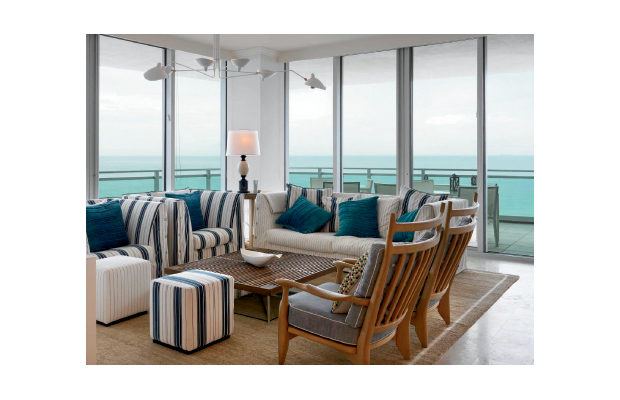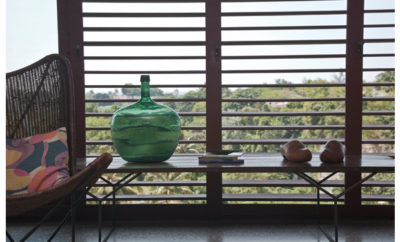
Feature
Seaside Chic

Upholstered Fendi Casa furniture gives the living room a nautical feel, as do the Pol Chambost lamp and Serge Mouille Spider ceiling lamp. On the floor is a rug by Doug and Gene Meyer. The oak Guillerme et Chambron chairs are from the 1950s.
The corner perch of the living room in this sunny oceanfront apartment in Bal Harbour, Florida has the feel and the perspective of a sleek, contemporary ocean liner. The designer, Frank de Biasi, had one major mandate here—that this apartment should not look like it was in New York. “I always try to understand how my clients envision life, how they entertain, how they envision their space,” he says. His objective was to create a living space that had a casual ease but retained a certain sophisticated outlook.
The apartment is what one might call a pied-à-plage—a winter getaway overlooking a broad expanse of beach and the vast blue-green sea. As such it’s designed to make sure that its occupants forget the doldrums of winter while shunning the clichés of Florida (and tropical) design. The palette is crisp and vivid, blues and greens
especially. (“It seemed only natural,” de Biasi says.)
The furniture is carefully chosen to reflect the kind of timelessness imparted by postwar design, with the addition of such contemporary pieces as a chandelier by Jeff Zimmerman of New York and a wall sculpture by the Argentine-born Carolina Sardi, who lives in Miami, though de Biasi first encountered her work in Paris. “I love to travel,” he says. His travels lead him through New York’s design galleries to Morocco’s bazaars and Paris’s Marché aux Puces—eyes wide open at all times. De Biasi has footholds in New York, Paris, Morocco, and Miami (and homes in all four, though his office is New York-based) and clients spread much farther around the world.
Born and reared in Richmond, Virginia, he first worked at Christie’s doing estate appraisals and honing his eye as he visited the homes of important collectors across the country. During that period he met the designer Peter Marino—“by chance,” de Biasi says—and went to work for him, spending thirteen years running the firm’s residential interiors department. In 2006 he founded his own firm.
For this apartment he sought to bring the inside out and the outside in. In the living room blue and white upholstered furniture stands on a rug the color of sand, while a Serge Mouille light hovers overhead in place of the more expected ceiling fan. A pair of mid-century French chairs from Guillerme et Chambron are carefully crafted, yet there’s a hint of driftwood in their form, too. Behind the chairs is a vast photo diptych shot in Hawaii by Jeffrey Rothstein; it is a crescendo of crashing waves full of the ocean’s ferocious energy. Lamps from the contemporary French designer Christophe Côme stand like bookends atop the bookshelf just below the photos.
In the dining room eight chrome Milo Baughman chairs from the 1970s are pulled up to an American claro walnut table commissioned from BDDW in New York. The chairs are upholstered in calfskin leather and are, de Biasi says, “very chartreuse.” He designed the plaid-patterned sideboard, which was then fabricated in cast resin by Kinon—“If I can’t find the perfect piece, I just make it,” he says. The sculpture by Carolina Sardi—this one is typical of her approach of breaking down large swathes of steel or other metal into small and almost fragile elements—fills the wall above. It’s an abstract work in white enameled metal that seems to offer any number of fitting metaphors for the apartment: is it shells, or perhaps gulls, a spray of seafoam, or clouds?
The connections are seamless and sophisticated, and in no way obvious. The pale elongated photos that hang over the bed—they are by the important Mexican-born American-based photographer Sze Tsung Leong and are part of his Horizons series begun in 2001—offer a distant echo of the real and reimagined seascapes found in the rest of the apartment. Rest assured that there is not a theme here, just a subtle connection of person to place.












